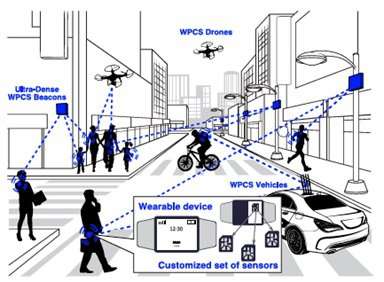Working principle of the system described in the article. Credit: Olga Galinina
RUDN mathematicians have suggested an incentive to encourage participants in mobile crowd-sensing. The data collected by sensors built into personal mobile devices (such as smartphones) can be exchanged for wireless battery charging services. The work was published in IEEE Wireless Communications.
The majority of modern smartphones are already equipped with sensors that register environmental information such as barometers, magnetometers, noise and light sensors, thermometers, and even harmful radiation and air humidity sensors. Next-generation gadgets are expected to have more complicated sensors, such as air pollution sensors and detectors of allergens. Crowd sensing allows a cellular network operator to anonymously collect the information detected by user sensors for monitoring, planning, and providing smart-city services. However, the main difficulty of this approach lies in the fact that the owners of the sensors are unwilling to share this information in order to protect personal data or save battery charge. The new incentive for providing potentially important information was suggested by RUDN mathematicians.
The key challenge of mass involvement into mobile crowd sensing is the low motivation of city dwellers to provide their data to operators for processing, even though it is anonymous. The solution was prompted by a well-known property of every mobile device—limited battery charge, which becomes especially important when the number of personal mobile devices increases. What if people could exchange the necessary data for energy? Having analyzed possible variants of such a system, the scientists agreed that it was applicable for crowd sensing.
A team of researchers from RUDN suggested a system in which portable devices could charge their batteries with radio energy received from one or several small base stations equipped with a wireless energy transfer interface working at an allocated frequency different from the one used for data transmission. Energy transmission would be based on radio frequency radiation within the range of 800-900 MHz, which increases the transmission radius to dozens of meters over current technologies.
The system works as follows: electronic sensors in the gadgets collect environment-related information and transmit it to base stations and to the cloud, where it is processed anonymously and can be used as a Big Data source for later analysis. A portable device that provides the data from a respective coverage area receives energy from a wireless transmission. The power of the devices is adjusted to meet standard human health protection requirements.
Notably, specialists believe that charging in accordance with the suggested model can support continuous work of small portable devices (with capacity up to 5 microwatts). However, while assessing the running time of an accumulator charged this way, it is important to consider different parameters of system operation (beam width, the user's macro- and micro-mobility, environmental objects that may block the beams, the number of sensors, base stations deployment and their density, etc), as well as the importance of the collected data at a given place and time. The final automated agreements between the operator and a smartphone may be regulated using auction schemes.
The deployment of such a system would be beneficial for everyone: the users that would be able to charge their portable devices, cellular network operators, and third-party companies that want to collect, analyze and monetize the data. Moreover, city authorities could also use this data to optimize many city services. User mobility modeling and initial calculations of energy received by portable devices from base stations show that the idea is achievable from the point of view of physics. However, moving it from the world of computer modeling to reality requires further study by physicists, mathematicians, and RF engineers, including the development of hardware and test beds, deployment planning, optimization of communication protocols, and creation of management mechanisms. The process would also involve specialists in social sciences to research the human factor.
More information: Olga Galinina et al. Wirelessly Powered Urban Crowd Sensing over Wearables: Trading Energy for Data, IEEE Wireless Communications (2018). DOI: 10.1109/MWC.2018.1600468
Provided by RUDN University
























